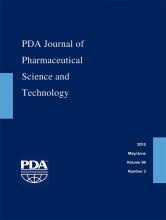Abstract
This article describes a four virus panel validation of EMD Millipore's (Bedford, MA) small virus–retentive filter, Viresolve® Pro, using TrueSpikeTM viruses for a Biogen Idec process intermediate. The study was performed at Charles River Labs in King of Prussia, PA. Greater than 900 L/m2 filter throughput was achieved with the approximately 8 g/L monoclonal antibody feed. No viruses were detected in any filtrate samples. All virus log reduction values were between ≥3.66 and ≥5.60. The use of TrueSpikeTM at Charles River Labs allowed Biogen Idec to achieve a more representative scaled-down model and potentially reduce the cost of its virus filtration step and the overall cost of goods. The body of data presented here is an example of the benefits of following the guidance from the PDA Technical Report 47, The Preparation of Virus Spikes Used for Viral Clearance Studies.
LAY ABSTRACT: The safety of biopharmaceuticals is assured through the use of multiple steps in the purification process that are capable of virus clearance, including filtration with virus-retentive filters. The amount of virus present at the downstream stages in the process is expected to be and is typically low. The viral clearance capability of the filtration step is assessed in a validation study. The study utilizes a small version of the larger manufacturing size filter, and a large, known amount of virus is added to the feed prior to filtration. Viral assay before and after filtration allows the virus log reduction value to be quantified. The representativeness of the small-scale model is supported by comparing large-scale filter performance to small-scale filter performance. The large-scale and small-scale filtration runs are performed using the same operating conditions. If the filter performance at both scales is comparable, it supports the applicability of the virus log reduction value obtained with the small-scale filter to the large-scale manufacturing process. However, the virus preparation used to spike the feed material often contains impurities that contribute adversely to virus filter performance in the small-scale model. The added impurities from the virus spike, which are not present at manufacturing scale, compromise the scale-down model and put into question the direct applicability of the virus clearance results. Another consequence of decreased filter performance due to virus spike impurities is the unnecessary over-sizing of the manufacturing system to match the low filter capacity observed in the scale-down model. This article describes how improvements in mammalian virus spike purity ensure the validity of the log reduction value obtained with the scale-down model and support economically optimized filter usage.
- © PDA, Inc. 2015
PDA members receive access to all articles published in the current year and previous volume year. Institutional subscribers received access to all content. Log in below to receive access to this article if you are either of these.
If you are neither or you are a PDA member trying to access an article outside of your membership license, then you must purchase access to this article (below). If you do not have a username or password for JPST, you will be required to create an account prior to purchasing.
Full issue PDFs are for PDA members only.
Note to pda.org users
The PDA and PDA bookstore websites (www.pda.org and www.pda.org/bookstore) are separate websites from the PDA JPST website. When you first join PDA, your initial UserID and Password are sent to HighWirePress to create your PDA JPST account. Subsequent UserrID and Password changes required at the PDA websites will not pass on to PDA JPST and vice versa. If you forget your PDA JPST UserID and/or Password, you can request help to retrieve UserID and reset Password below.






